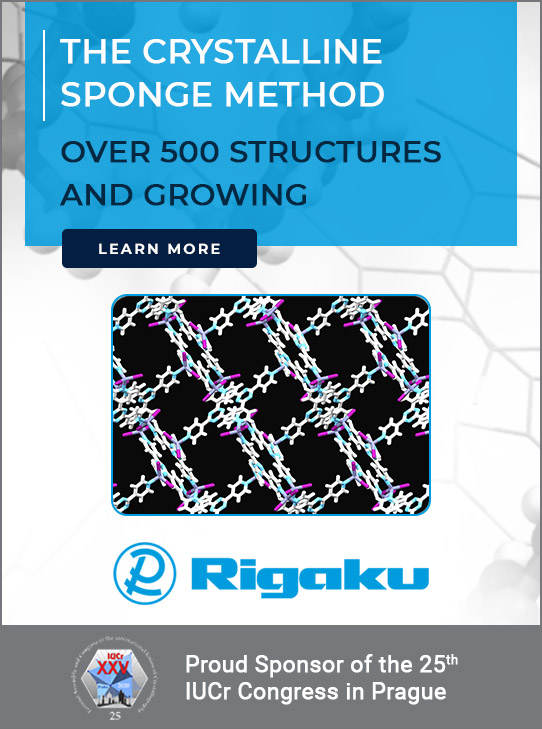


Editorial
Editorial
![Thumbnail [Thumbnail]](https://www.iucr.org/__data/assets/image/0004/146326/ezgif.com-crop.gif)
Hearty congratulations to John Goodenough, one of this year’s recipients of the Nobel Prize in Chemistry for his contributions to the development of Li-ion batteries. At the great age of 97, this has been long, long overdue. John came to Oxford in 1976, which is where he made his original discoveries. We both arrived in Oxford at the same time and we used to joke that he, a physicist by training, found himself in a Chemistry Department, while I, a chemist by training, found myself in a Physics Department. I still recall his tendency to laugh so earth-shatteringly loudly that it echoed over great distances.
In the previous issue of the IUCr Newsletter, we had an article on the reference to crystallography in the movie “No Highway in the Sky”, and I asked if anyone could tell us of any other movies in which crystals or crystallography had figured. I received several emails and tweets pointing to the film “The Andromeda Strain”; see Letters to the Editor.
I have also discovered a reference to crystals in the 2008 movie “Journey to the Center of the Earth” directed by Eric Brevig. The film is a load of scientific tosh, as you would expect of course, but approximately 34 minutes into the film, the volcanologist Professor Trevor Anderson (played by Brendan Fraser) accompanied by a young Sean Anderson (Josh Hutcherson) and the beautiful Hannah Ásgeirsdóttir (Anita Briem) arrive deep underground at a place where they find huge rubies, emeralds, diamonds and … feldspar! The diamonds of course are outrageously enormous. At this point our hero, the Professor, announces slowly and deliberately with a look of wonder “Crystals are frequently formed … and found … in volcanic tubes”. The three characters then fall through a floor made of thin layers of muscovite. I think that this is more or less the only scene in the movie that can claim any scientific credibility! Nonetheless I can recommend it if you have nothing else to do as it is quite fun to watch.
![[Nespolo and Glazer]](https://www.iucr.org/__data/assets/image/0008/146456/Nespolo-and-Glazer.png) IUCr Newsletter Editor Mike Glazer (right) in discussion with IUCr Newsletter author Massimo Nespolo at ECM32.
IUCr Newsletter Editor Mike Glazer (right) in discussion with IUCr Newsletter author Massimo Nespolo at ECM32.
We also publish a very interesting account by a young man from Senegal about his experiences in learning about crystallography through the IUCr’s Crystallography in Africa initiative. His enthusiasm just shines through this article. This is a wonderful example of the way in which the IUCr does such a lot of good things around the world, and bringing the continent of Africa into our community has to be an important and welcome development for the future. It is something that a number of crystallographers from different countries and commercial companies have been working very hard to achieve, and they deserve our support.
In this issue we have another important article from Massimo Nespolo, this time on the vexed question of the use of the term “low dimensions” in crystals. This is yet another of those areas where non-specialists tie themselves into knots, especially when trying to express ideas to do with dimensionality in crystals and the space in which the crystals exist.
Fifty years or so ago when I began research in crystallography, crystals consisted of regular arrangements of atoms and molecules. And this was the way in which we usually thought of them then. We were well aware that what we were looking at was the ‘average’ structure and that in reality the near-perfect repetition of an ideal crystal was not the whole story. Over the years it has become ever more apparent that it is in the departure from regularity where the really interesting science often resides, especially if we want to understand how physical properties arise based on the crystal structure. And so we have seen an increasing interest in studies of what we can call ‘local structure’. In other words, attention is moving ever more to understanding ‘real’ crystals. Simon Billinge, one of the experts on real structures and the techniques used to study them, has written in this issue of the IUCr Newsletter an excellent thought-provoking article looking to the future of crystallography.
Finally, John Helliwell has provided a thoughtful piece on a subject that we don’t often see discussed these days, but is in the tradition of the thinking of some of our great crystallographers of the past such as Lonsdale, Bernal, Hodgkin and Pauling.
If you want to comment on this, or anything else relevant to crystallography, the IUCr, etc., do please email me with your thoughts and we can then publish them in following issues either as separate articles or as Letters to the Editor.
Copyright © - All Rights Reserved - International Union of Crystallography







